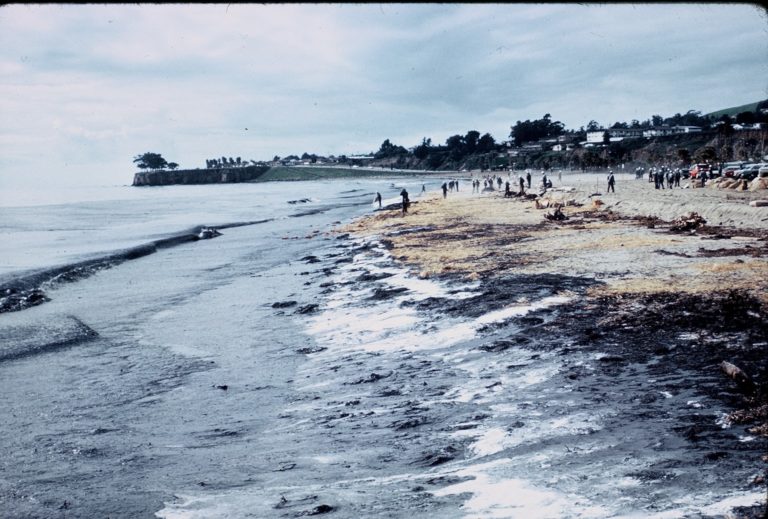
By Kira Redmond, executive director of Santa Barbara Channelkeeper. Reposted with permission by Santa Barbara Channelkeeper.
Fifty years ago today was a critical turning point in history. On January 28, 1969, an oil platform in the Santa Barbara Channel experienced an uncontrolled blowout which lasted for eight days and created a slick that covered over eight hundred square miles of ocean from the Channel Islands to the Mexican border. For weeks afterward, dramatic images of oil-soaked birds and miles of beaches coated with thick black sludge were beamed into TV sets in living rooms across the nation, sparking a widespread environmental consciousness that made environmental protection a major national issue. The blowout, which ultimately released more than three million gallons of oil over the course of several months and blackened beaches along forty miles of coastline, was dubbed the “ecological shot heard round the world.”
The blowout was the catalyst for what many cite as the birth of the modern environmental movement in the United States. In its wake, Earth Day and numerous environmental groups were born and a wave of environmental legislation was enacted, including the National Environmental Policy Act and the Clean Water Act. The State of California has not issued a new oil lease in State waters since the ’69 spill. It was a game-changer.
A half-century later, we find ourselves at another critical turning point. Climate change is upon us with a vengeance, and we’re feeling the burn here in California with record-breaking drought, devastating wildfires, extreme weather events, deadly mudslides, ocean acidification and rising temperatures wreaking havoc on our environment, communities, and economy. Yet the Trump Administration is recklessly proposing to re-open massive tracts of federal waters and lands to new and expanded oil drilling, executing a full-frontal attack to gut our nation’s bedrock environmental laws and agencies – the very ones borne out of that tide-turning oil spill – and denying that climate change even exists.
Santa Barbara Channelkeeper and Waterkeepers around the globe are on the front lines, working tirelessly to fight further oil development, keep fossil fuels in the ground, and advocate for renewable energy and smart measures to improve our resiliency to climate change. And we’re making an impact. With the active support of Santa Barbara Channelkeeper and other Waterkeepers across the Golden State, last year the California Legislature enacted critical bills that prohibit the state from issuing permits for leases and associated infrastructure related to any oil extraction, thus severely limiting the options available to offshore oil development in federal waters. Santa Barbara Channelkeeper and the Environmental Defense Center just secured a moratorium on any new permits for fracking from offshore oil platforms in the Pacific Outer Continental Shelf until federal agencies determine and address potential impacts to endangered and threatened species, of which there are many off our shores. We’ve helped defeat proposals for new oil and gas projects, secure stringent limits and requirements for discharges from oil platforms, and extinguish 30 undeveloped oil leases off the southern California coast. And in the wake of another horrific oil spill on the Santa Barbara coast in 2015, we worked successfully with lawmakers to institute new reforms to improve pipeline safety and oil spill prevention and response. We’re also addressing climate change locally by championing bans on oil-based single-use plastic “convenience” items, promoting sustainable alternatives to energy-intensive water supplies like desalination, aiding ocean acidification research, and stewarding marine protected areas to enhance our resiliency to climate change.
While we’ve indeed come a long way since the Santa Barbara oil spill 50 years ago, we have so much more to do. The environmental threats we face today are dire, daunting and unprecedented. But each and every one of us can make a difference. We must think globally and act locally. Let’s use the anniversary of that tragic disaster as a renewed call to action, a motivation to fight even harder and smarter, so that our planet is a better, healthier place to live in another 50 years. The stakes are too high to do anything but.
*Feature image by James “Bud” Bottoms, 1969